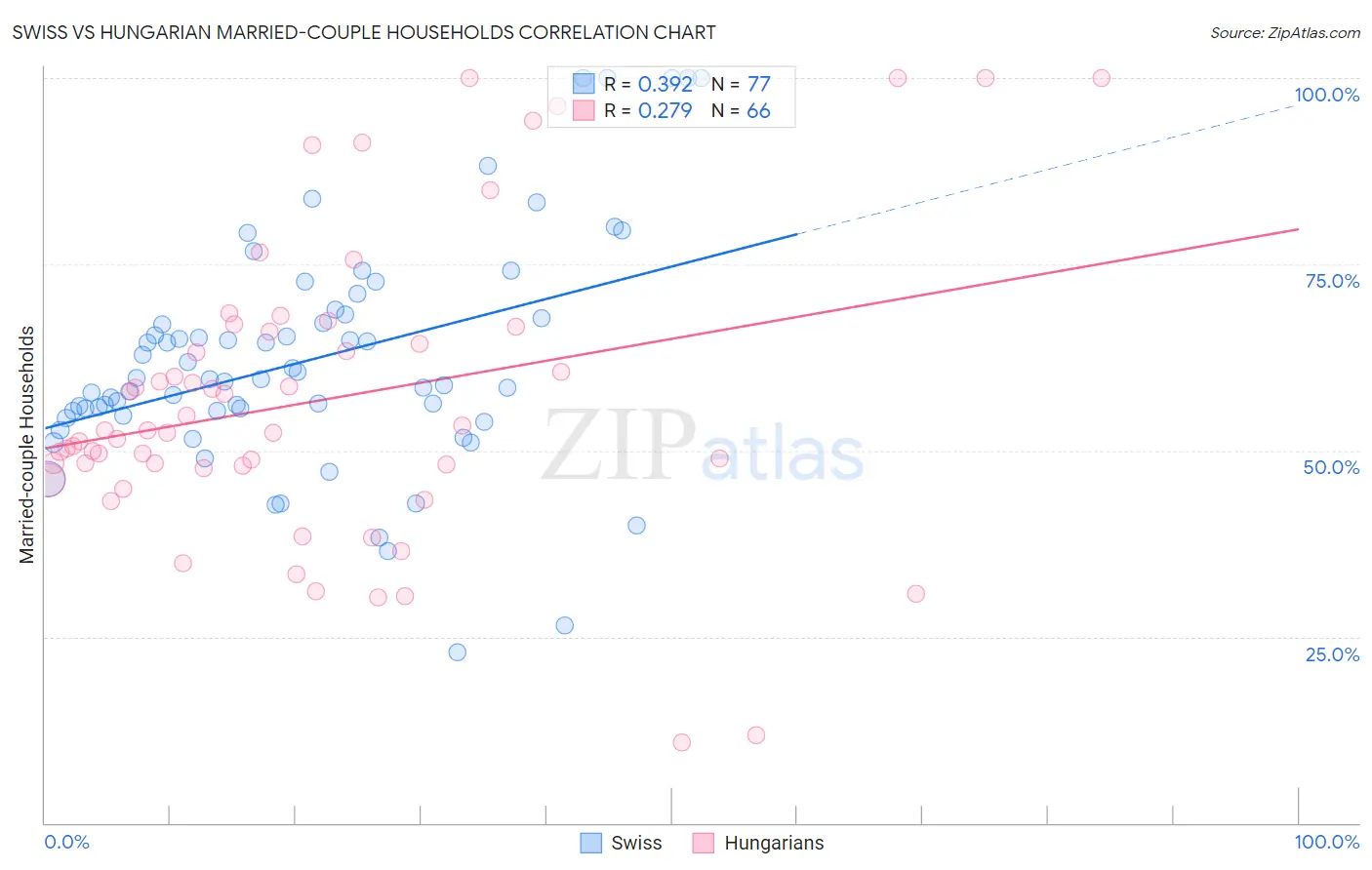Swiss vs Hungarian Married-couple Households
COMPARE
Swiss
Hungarian
Married-couple Households
Married-couple Households Comparison
Swiss
Hungarians
49.9%
MARRIED-COUPLE HOUSEHOLDS
100.0/ 100
METRIC RATING
12th/ 347
METRIC RANK
49.1%
MARRIED-COUPLE HOUSEHOLDS
99.8/ 100
METRIC RATING
32nd/ 347
METRIC RANK
Swiss vs Hungarian Married-couple Households Correlation Chart
The statistical analysis conducted on geographies consisting of 464,742,560 people shows a mild positive correlation between the proportion of Swiss and percentage of married-couple family households in the United States with a correlation coefficient (R) of 0.392 and weighted average of 49.9%. Similarly, the statistical analysis conducted on geographies consisting of 485,875,006 people shows a weak positive correlation between the proportion of Hungarians and percentage of married-couple family households in the United States with a correlation coefficient (R) of 0.279 and weighted average of 49.1%, a difference of 1.8%.

Married-couple Households Correlation Summary
| Measurement | Swiss | Hungarian |
| Minimum | 23.0% | 10.9% |
| Maximum | 100.0% | 100.0% |
| Range | 77.0% | 89.1% |
| Mean | 62.1% | 56.7% |
| Median | 59.6% | 52.5% |
| Interquartile 25% (IQ1) | 55.0% | 47.9% |
| Interquartile 75% (IQ3) | 67.9% | 65.9% |
| Interquartile Range (IQR) | 12.9% | 18.0% |
| Standard Deviation (Sample) | 15.5% | 19.9% |
| Standard Deviation (Population) | 15.4% | 19.8% |
Demographics Similar to Swiss and Hungarians by Married-couple Households
In terms of married-couple households, the demographic groups most similar to Swiss are Immigrants from Korea (49.9%, a difference of 0.17%), Burmese (49.8%, a difference of 0.30%), Korean (49.7%, a difference of 0.44%), Swedish (49.7%, a difference of 0.47%), and Immigrants from Hong Kong (49.6%, a difference of 0.63%). Similarly, the demographic groups most similar to Hungarians are Native Hawaiian (49.1%, a difference of 0.060%), Bolivian (49.2%, a difference of 0.17%), Maltese (49.2%, a difference of 0.18%), German (49.2%, a difference of 0.19%), and Bhutanese (49.3%, a difference of 0.38%).
| Demographics | Rating | Rank | Married-couple Households |
| Swiss | 100.0 /100 | #12 | Exceptional 49.9% |
| Immigrants | Korea | 100.0 /100 | #13 | Exceptional 49.9% |
| Burmese | 100.0 /100 | #14 | Exceptional 49.8% |
| Koreans | 99.9 /100 | #15 | Exceptional 49.7% |
| Swedes | 99.9 /100 | #16 | Exceptional 49.7% |
| Immigrants | Hong Kong | 99.9 /100 | #17 | Exceptional 49.6% |
| English | 99.9 /100 | #18 | Exceptional 49.6% |
| Europeans | 99.9 /100 | #19 | Exceptional 49.6% |
| Scandinavians | 99.9 /100 | #20 | Exceptional 49.6% |
| Norwegians | 99.9 /100 | #21 | Exceptional 49.5% |
| Asians | 99.9 /100 | #22 | Exceptional 49.5% |
| Dutch | 99.9 /100 | #23 | Exceptional 49.5% |
| Czechs | 99.9 /100 | #24 | Exceptional 49.4% |
| Immigrants | Philippines | 99.9 /100 | #25 | Exceptional 49.3% |
| Immigrants | Scotland | 99.8 /100 | #26 | Exceptional 49.3% |
| Bhutanese | 99.8 /100 | #27 | Exceptional 49.3% |
| Germans | 99.8 /100 | #28 | Exceptional 49.2% |
| Maltese | 99.8 /100 | #29 | Exceptional 49.2% |
| Bolivians | 99.8 /100 | #30 | Exceptional 49.2% |
| Native Hawaiians | 99.8 /100 | #31 | Exceptional 49.1% |
| Hungarians | 99.8 /100 | #32 | Exceptional 49.1% |